
Alexander Graham Bell was a Scottish-born inventor, scientist and engineer who is credited with patenting the first practical telephone. He also co-founded the American Telephone and Telegraph Company (AT&T) in 1885.

Glenn Hammond Curtiss was an American aviation and motorcycling pioneer, and a founder of the U.S. aircraft industry. He began his career as a bicycle racer and builder before moving on to motorcycles. As early as 1904, he began to manufacture engines for airships. In 1908, Curtiss joined the Aerial Experiment Association, a pioneering research group, founded by Alexander Graham Bell at Beinn Bhreagh, Nova Scotia, to build flying machines.

Curtiss Aeroplane and Motor Company was an American aircraft manufacturer originally founded by Glenn Hammond Curtiss and Augustus Moore Herring in Hammondsport, New York. After significant commercial success in its first decades, it merged with the Wright Aeronautical to form Curtiss-Wright Corporation.
The history of the Royal Canadian Air Force begins in 1914, with the formation of the Canadian Aviation Corps (CAC) that was attached to the Canadian Expeditionary Force during the First World War. It consisted of one aircraft that was never called into service. In 1918, a wing of two Canadian squadrons called the Canadian Air Force (CAF) was formed in England and attached to the Royal Air Force, but it also would never see wartime service. Postwar, an air militia also known as the Canadian Air Force was formed in Canada in 1920. In 1924 the CAF was renamed the Royal Canadian Air Force (RCAF) when it was granted the royal title by King George V. The RCAF existed as an independent service until 1968.

Baddeck is a village in northeastern Nova Scotia, Canada. It is situated in the centre of Cape Breton, approximately 6 km east of where the Baddeck River empties into Bras d'Or Lake.
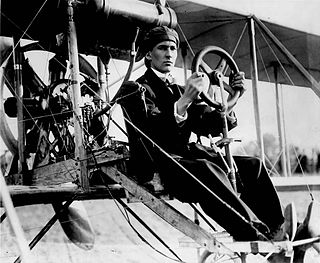
The Aerial Experiment Association (AEA) was a Canadian-American aeronautical research group formed on 30 September 1907, under the leadership of Dr. Alexander Graham Bell.

The Cygnet was an extremely unorthodox early Canadian aircraft, with a wall-like "wing" made up of 3,393 tetrahedral cells. It was a powered version of the Cygnet tetrahedral kite designed by Dr Alexander Graham Bell in 1907 and built by the newly founded Aerial Experiment Association.

John Alexander Douglas McCurdy, was a Canadian aviation pioneer and the 20th Lieutenant Governor of Nova Scotia from 1947 to 1952.
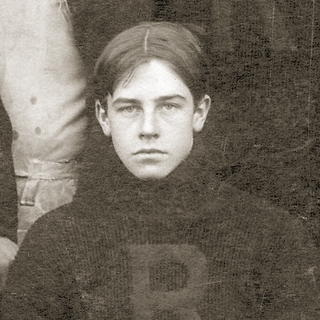
Frederick Walker Baldwin, also known as Casey Baldwin, paternal grandson of Canadian reform leader Robert Baldwin, was a hydrofoil and aviation pioneer and partner of the famous inventor Alexander Graham Bell. He was manager of Graham Bell Laboratories from 1909–32, and represented Victoria in the Nova Scotia Legislature from 1933–37, where he was instrumental in bringing about the creation of Cape Breton Highlands National Park. In 1908, he became the first Canadian and British subject to fly an airplane.

The Fairchild 45-80 Sekani was a Canadian twin-engined transport aircraft developed in Canada in the late 1930s. Although the 45-80 was the largest bush plane developed by Fairchild, its poor performance doomed the project, and nearly the company.
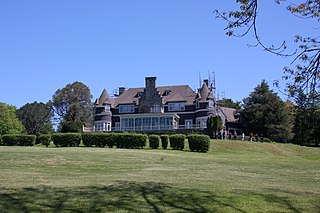
Beinn Bhreagh is the name of the former estate of Alexander Graham Bell, in Victoria County, Nova Scotia, Canada. It refers to a peninsula jutting into Cape Breton Island's scenic Bras d'Or Lake approximately three kilometres southeast of the village of Baddeck, forming the southeastern shore of Baddeck Bay.
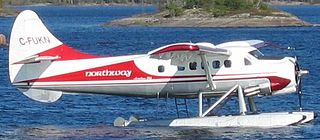
The history of aviation in Canada begins with the first manned flight in a balloon at Saint John, New Brunswick in 1840. The development of the aviation industry in Canada was shaped by the interplay of Canadian national ambitions, national and international politics, economics, and technology. Experimental aviation started in Canada with the test flights of Bell's Silver Dart in 1909, following the epochal flight of the Wright Brothers in 1903. The experimental phase gave way to use of aircraft in warfare. Many Canadians served in the British Royal Flying Corps and Royal Air Force during the First World War.

Alexander Graham Bell National Historic Site is a 10-hectare (25-acre) property in Baddeck, Cape Breton, Nova Scotia, Canada, overlooking the Bras d'Or Lakes. The site is a unit of Parks Canada, the national park system, and includes the Alexander Graham Bell National Historic Site, which contains the largest repository of artifacts and documents from Bell's years of experimental work in Baddeck. This site was designated a National Historic Site in 1952.
Baddeck, Nova Scotia is a village founded in 1908, with a history stretching back to early Mi'kmaq, French, and British settlements. The village was home to Alexander Graham Bell and was witness to the first flight in the commonwealth with Bell's Silver Dart.
The Canadian Aerodrome Company was the first commercial enterprise in the British Empire to design and manufacture aircraft. The company was formed following the dissolution of Alexander Graham Bell's Aerial Experiment Association. The company was established by Frederick W. "Casey" Baldwin and J.A.D. McCurdy in 1909, with the financial backing of Alexander Graham Bell. The company was headquartered in Baddeck, Nova Scotia at the Kite House at Bell's Beinn Bhreagh estate.

The Hubbard Monoplane, also nicknamed "Mike", was an early aircraft designed by John McCurdy and built by the Canadian Aerodrome Company.

HD-4 or Hydrodome number 4 was an early research hydrofoil watercraft developed by the scientist Alexander Graham Bell. It was designed and built at the Bell Boatyard on Bell's Beinn Bhreagh estate near Baddeck, Nova Scotia. In 1919, it set a world marine speed record of 70.86 miles per hour (114.04 km/h).
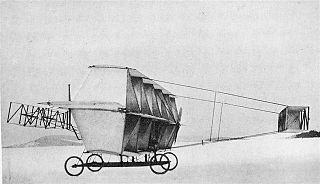
The Oionus I was a tetrahedral triplane built for Alexander Graham Bell. It was the culmination of Bell's experiments with kites built at Baddeck, Nova Scotia. The aircraft's design combined those of the Aerial Experiment Association (AEA)'s AEA Silver Dart biplane and his AEA Cygnet kite. It was Bell's final aviation pursuit and Canada's first and only triplane design. The aircraft attempted a test flight in March 1910, but failed to achieve flight.
The Bell Boatyard was a boatbuilding facility which operated as part of Alexander Graham Bell's laboratories in Baddeck, Nova Scotia from 1885 to 1928. The boatyard built experimental craft, lifeboats and yachts during the first part of the twentieth century. The Bell yard was notable for its dual focus on both experimental and traditional boats and for its employment of large numbers of female boatbuilders.



















